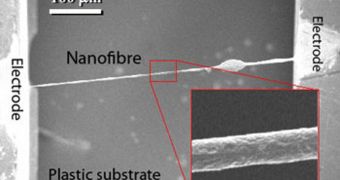Researchers have been looking for methods of improving energy conversion and production from various sources for many years. One of these sources is movement, something that we do even in our sleep, but which is energy lost. Investigators looking at methods of tapping into these immense energy reserves have attempted to develop a number of mechanisms to convert this resource into usable electrical current, but research thus far has come short of achieving this objective.
But an international collaborative effort, between researchers in the United States, China and Germany has recently managed to make a giant stride in this direction. The group created a polymer nanofiber that is able to convert energy 20 percent more efficiently than possible to this point. These results could have incredible commercial potential, as they could for example be used to power up wireless sensors, and produce clothes that can charge portable electronics. Previous studies have also attempted to harness the power of walking for producing energy to power up batteries.
“The key advance made here is the enhancement of energy conversion efficiency to 20 per cent. This is a great accomplishment, which shows that converting mechanical energy can be an effective way to provide power in the future, especially for self-powered nano- and micro-systems,” says Georgia Institute of Technology (Georgia Tech) expert Zhong Lin Wang. He was the investigator that pioneered the creation and development of zinc oxide piezoelectric nanogenerators. Piezoelectrics are materials that are capable of producing electric potential when mechanical stress is applied on them. Most often, these materials are special kinds of crystals or ceramics.
The nanogenerators themselves consist of organic nanofibres, Chemistry World reports. These fibers are also made from piezoelectrics. Unlike other researches, which focused on inorganic materials, the new one saw the generators being made from poly(vinylidene fluoride), or PVDF. Researchers from the University of California in Berkeley (UCB), led by expert Liwei Lin, also managed to make the devices more elegant, and devised a fairly straightforward method of stretching them (the mechanical stress required) and aligning their dipoles.

 14 DAY TRIAL //
14 DAY TRIAL //